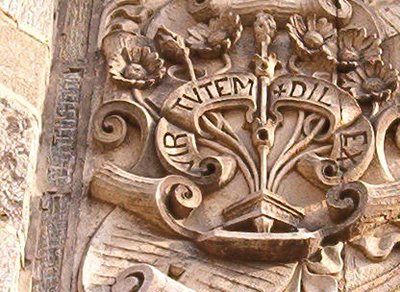I have chosen to tell the truth about virtue
I was walking through Pembroke Arch on Bryn Mawr's campus the other day and by the time I'd crossed Merion Ave. something odd occurred to me.
Just above the arch on the left side as you're exiting there's an inscription that reads VIRTVTEM DILEXI, "I have loved virtue."
I thought I must have misread it because the college's motto is VERITATEM DILEXI (supposed to mean 'I have chosen truth'). This page at Bryn Mawr actually claims that the motto is inscribed on Pem Arch.
Later in the day I passed through and took another look. Sure enough it says VIRTVTEM.
As far back as 1908 M. Carey Thomas, the famed president of Bryn Mawr College, had instructed that the motto be placed upon the library's book plates. She quoted the motto in its conventional form, "VERITATEM DILEXI."
It has made its way onto the official seal (seen here), but is it correct? Is it possible that inscription was misread a century ago and that the misreading stuck?
As proof I've taken photos of the inscription:
You'll probably want to have a closer look:
I suspect the phrase to be adapted from a sentiment in Cicero (whose periodic style does not lend itself to epigrams and that we should expect to be condensed):
Nihil est enim virtute amabilius, nihil quod magis adliciat ad diligendum, quippe cum propter virtutem et probitatem etiam eos, quos numquam vidimus, quodam modo diligamus.
(De amicitia 28)
That's just a guess of course.
I've found several references to 'VERITATEM DILEXI' as the epitaph chosen by the 19th century scholar Ernest Renan (1823-1892) (cf. Discours & Conférences, 39). It was the title of a poem written in his honor the year after his death by Mary Darmesteter. Darmesteter (alias Madame James Darmesteter, alias A. Mary F. Robinson, alias Mary Duclaux, alias Madame Duclaus) wrote a biography of Renan in 1895. Perhaps interest in Renan and his ideas (chiefly his philosophical ideas on what constitutes a nation) kept his chosen epitaph at the fore of people's minds and caused them to confuse it with the similar-sounding though quite different VIRTVTEM DILEXI.
Is it time to resort to the epigraphic evidence and to emend the text of the motto? This seems to me like a clear case of corruption, though I'm not sure many will be happy to let 'virtue' replace the accepted 'truth.'


2 comments:
That is fascinating! I wonder what happened. Let me know if your investigation makes any progress.
I don't like that variation half so much as the one inscribed on a sidewalk near Rock Arch, "Feminasque veritatem dilexi".
Post a Comment